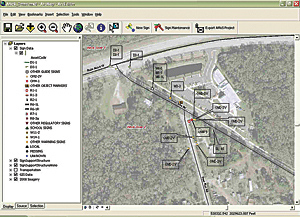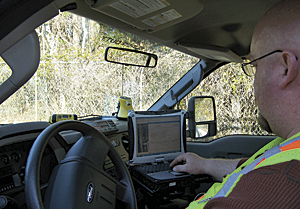Automating Street Sign Maintenance in St. Johns County
System Helps County Remain Compliant with Government Accounting Standards
Highlights
- The county's computerized maintenance management system is linked with ArcGIS to expedite sign repair and replacement.
- The system locates and references each street sign with traffic device codes and a review of its maintenance history.
- With GIS, the county can track costs associated with assets and their predicted life span.

The computerized maintenance management system helps St. Johns County easily locate and reference each street sign, determine the MUTCD code for that sign or group of signs, and review maintenance history.
Founded in 1821, St. Johns County is located on the Atlantic Ocean in northeastern Florida. The many historical sites in the area attract millions of visitors annually, making tourism an important component of the local economy.
Cars and buses provide the primary means of transportation for both residents and visitors, increasing the need for regular road maintenance. To help manage repairs, the county's public works department has implemented a number of GIS-based maintenance programs.
Rocky S. Agbunag, GIS coordinator for St. Johns County, says, "We have used GIS for about four years. Previously, all documentation and work orders were done on paper. It was very time consuming, and work locations for the crews were indicated by specifying nearby intersections or general areas. Performance reports relied on guesstimates."
To automate its roadway data collection, the county invested in a van outfitted with video cameras, still cameras, and computers so that the county's 40,000 roadway signs and 15,000 sign support structures could be regularly inspected and the collected data managed by ArcGIS Server in a SQL Server database. These surveys are supplemented by field crews that use ArcPad to collect the location and condition of newly repaired or installed signs to minimize the loss of data between the time the countywide inventories are completed and when the resultant data is uploaded.
Building on the success of this project, the county hired Esri Partner Woolpert, Inc., of Dayton, Ohio, specialists in transportation asset management, to develop an application to collect, store, and deliver the geospatial data and related imagery of its street sign inventories.
Woolpert developed the Automated Maintenance of Signs (AMoS) application using Visual Basic and the Distributed Geodatabase toolbar in ArcGIS. AMoS extracts a version of the geodatabase to export for field use. The exported geodatabase is available on the field crew's laptops and can be used to validate existing information or create new data. If a new sign is installed, the crew will fill out a form with basic information about the sign, including its corresponding Manual on Uniform Traffic Control Devices (MUTCD) code. The sign is photographed and its file name stored in the attribute table. The photo is later moved to a shared network folder so that it can be hyperlinked to its physical location on the map. Once the maintenance is complete, the field data is imported into the geodatabase for reconciling and posting.
The AMoS system helps St. Johns County easily locate and reference each street sign, determine the MUTCD code for that sign or group of signs, and review its maintenance history. The system is also used to analyze the types of signs used and the quantity the county will need in the future so that it can budget for labor and materials costs.

The CMMS helps manage public works assets and allocate resources for fieldwork.
"By georeferencing all the information related to our county roadway signage, we have realized a quantifiable return on investment with our GIS. It also allows us to remain compliant with GASB 34," says Agbunag. (GASB 34, or Governmental Accounting Standards Board Statement 34, mandates state and local governments to report financial transactions, for example, the value of infrastructure assets.)
Woolpert linked the county's computerized maintenance management system (CMMS) with ArcGIS to expedite sign repair and replacement. The CMMS helps manage public works assets and allocates resources for fieldwork. It records information such as inspection schedules, maintenance, and the reflective capabilities for individual signs. By coupling this information with the GIS, managers not only have an immediate inventory and report on the condition of their assets but also know exactly where those assets are in relationship to the daily maintenance schedules of field crews. In the event of an emergency, this knowledge allows nearby crews to be quickly reassigned to take remedial action, if necessary. Since the CMMS and the GIS are integrated, files can be accessed through either system.
Because the county does performance-based budgeting with its CMMS, it can track costs associated with assets and their predicted life span. Using the CMMS in conjunction with AMoS is also very useful in determining better budgetary planning estimates for future years.
For more information, contact Rocky S. Agbunag, GIS coordinator, St. Johns County (e-mail: ragbunag@sjcfl.us).